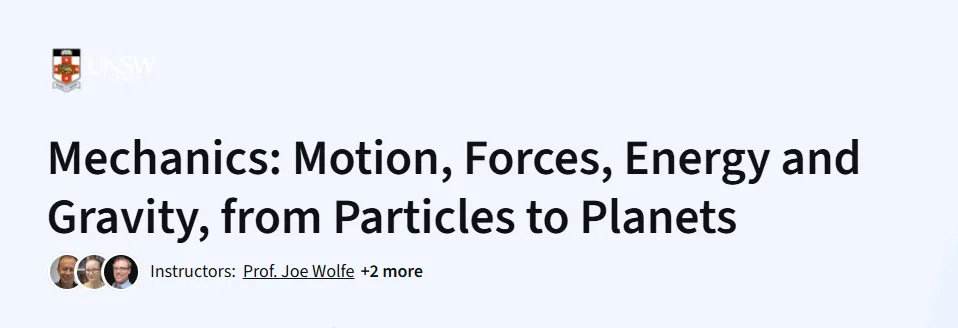What will you learn in Mechanics: Motion, Forces, Energy and Gravity, from Particles to Planets Course
Understand the foundational principles of Newtonian mechanics.
Analyze motion and forces in everyday and astronomical systems.
Learn to apply conservation laws of energy and momentum.
Gain skills in solving physics problems from basic to intermediate level.
Program Overview
Module 1: Introduction to Forces and Motion
⏱️ 1 week
Topics: Newton’s Laws, motion in one dimension, acceleration.
Hands-on: Solving motion problems with graphs and equations.
Module 2: Energy and Work
⏱️ 1 week
Topics: Kinetic and potential energy, work-energy theorem.
Hands-on: Calculating work and energy transformations.
Module 3: Momentum and Collisions
⏱️ 1 week
Topics: Linear momentum, impulse, elastic and inelastic collisions.
Hands-on: Real-world collision scenarios and physics simulations.
Module 4: Circular Motion and Gravity
⏱️ 1 week
Topics: Orbits, centripetal force, Newton’s law of gravitation.
Hands-on: Motion analysis of satellites and planetary bodies.
Module 5: Rotational Motion and Torque
⏱️ 1 week
Topics: Angular momentum, torque, rotational kinematics.
Hands-on: Rotational systems problem sets and video explanations.
Get certificate
Job Outlook
Strong foundation for careers in physics, astronomy, and engineering.
Ideal for students preparing for STEM degree programs or exams.
Enhances analytical skills needed in research and space sciences.
High demand for physics educators and data analysts with modeling skills.
Specification: Mechanics: Motion, Forces, Energy and Gravity, from Particles to Planets
|
FAQs
- Basic algebra and trigonometry are sufficient.
- Calculus helps but isn’t mandatory for most topics.
- The course focuses on concepts with guided examples.
- Math is introduced step-by-step alongside physics.
- Extra support resources are often provided.
- Explains motion of cars, sports, and falling objects.
- Connects these principles to satellites and planetary orbits.
- Shows how the same laws apply from micro to cosmic scales.
- Builds appreciation for the universality of physics.
- Bridges curiosity between daily life and astronomy.
- Perfect for high school graduates entering STEM fields.
- Strengthens fundamentals before advanced physics.
- Includes problem-solving similar to college exams.
- Encourages scientific thinking and logical analysis.
- Builds confidence for engineering and physics programs.
- Includes problem-solving exercises and visual examples.
- Demonstrates collisions and orbits via simulations.
- Helps learners visualize abstract mechanics concepts.
- May include quizzes for interactive reinforcement.
- Bridges theory with practical applications.
- Foundation for careers in physics, astronomy, and engineering.
- Useful for aerospace and robotics fields.
- Strengthens analytical skills for data-driven roles.
- Valuable for teaching and science communication.
- Prepares learners for research or higher STEM education.





